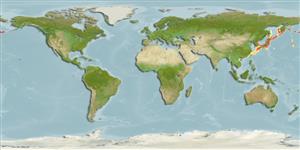Elasmobranchii (tubarões e raias) (sharks and rays) >
Rajiformes (Skates and rays) >
Arhynchobatidae (Softnose skates)
Etymology: Bathyraja: Greek, bathys = deep + Latin, raja, -ae = a ray (Raja sp) (Ref. 45335).
Environment: milieu / climate zone / depth range / distribution range
Ecologia
marinhas batidemersal; intervalo de profundidade 120 - 2000 m (Ref. 50550). Deep-water
Northwest Pacific: off northern Japan (Ref. 559) and Sea of Okhotsk (Ref. 41724).
Length at first maturity / Tamanho / Peso / Idade
Maturity: Lm 97.0, range 89 - 105 cm
Max length : 126 cm TL macho/indeterminado; (Ref. 56527); peso máx. Publicado: 10.6 kg (Ref. 56527)
Descrição breve
Chaves de identificação | Morfologia | Morfometria
Differs from its congeners in having a dark purplish brown color at both sides of the body; eyeball as long as the spiracle; interorbital space smooth; clasper with deep cleft (Ref. 75535).
Deep-sea species (Ref. 8630). Small individuals feed on crabs and annelids, while larger ones prey on fish and cephalopods (Ref. 27640). Oviparous. Distinct pairing with embrace. Young may tend to follow large objects, such as their mother (Ref. 205). Eggs are oblong capsules with stiff pointed horns at the corners deposited in sandy or muddy flats (Ref. 205). Egg capsules are 10.9-11.3 cm long and 6.5-6.7 cm wide (Ref. 41249, 41253).
Life cycle and mating behavior
Maturities | Reprodução | Spawnings | Egg(s) | Fecundities | Larvas
Oviparous, paired eggs are laid. Embryos feed solely on yolk (Ref. 50449). Distinct pairing with embrace. Young may tend to follow large objects, such as their mother (Ref. 205). Eggs have horn-like projections on the shell (Ref. 205).
McEachran, J.D. and K.A. Dunn, 1998. Phylogenetic analysis of skates, a morphologically conservative clade of elasmobranchs (Chondrichthyes: Rajidae). Copeia 1998(2):271-290. (Ref. 27314)
Categoria na Lista Vermelha da IUCN (Ref. 130435)
Ameaça para o homem
Harmless
Utilização humana
Ferramentas
Relatórios especiais
Descarregue XML
Fontes da internet
Estimates based on models
Preferred temperature (Ref.
123201): 0.3 - 4.1, mean 2 °C (based on 173 cells).
Phylogenetic diversity index (Ref.
82804): PD
50 = 0.5000 [Uniqueness, from 0.5 = low to 2.0 = high].
Bayesian length-weight: a=0.00427 (0.00269 - 0.00676), b=3.09 (2.96 - 3.22), in cm total length, based on LWR estimates for this species & Genus-body shape (Ref.
93245).
Nível Trófico (Ref.
69278): 4.1 ±0.72 se; based on food items.
Resiliência (Ref.
120179): Baixo, tempo mínimo de duplicação da população 4,5 - 14 anos (Fec assumed to be <100).
Fishing Vulnerability (Ref.
59153): Very high vulnerability (76 of 100).
